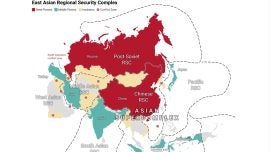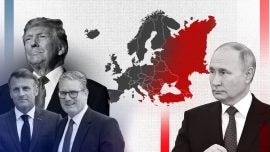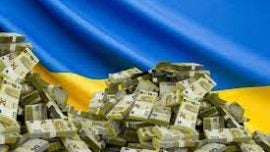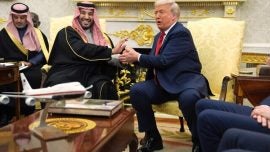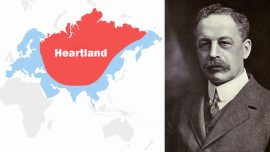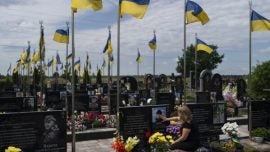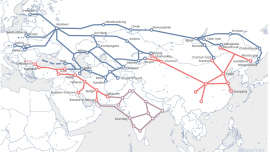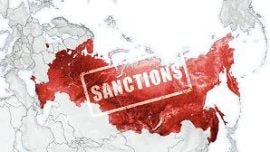
With the end of the Cold War, international non-state groups involved in transnational organised crime and international terrorism emerged as political actors, and drug cartels are no exception.
Previously, these organisations had either existed on the margins of political institutions – with the exception of the failed attempt by the leader of the Colombian drug cartels, Pablo Escobar, to influence or control Colombia’s domestic politics, first indirectly and later directly – or were decentralised elements of the geostrategic rivalry between the United States (US) and the Soviet Union, but currently the cultivation, processing, wholesale and commercialisation of cocaine constitute one of the most profitable business models in the world.
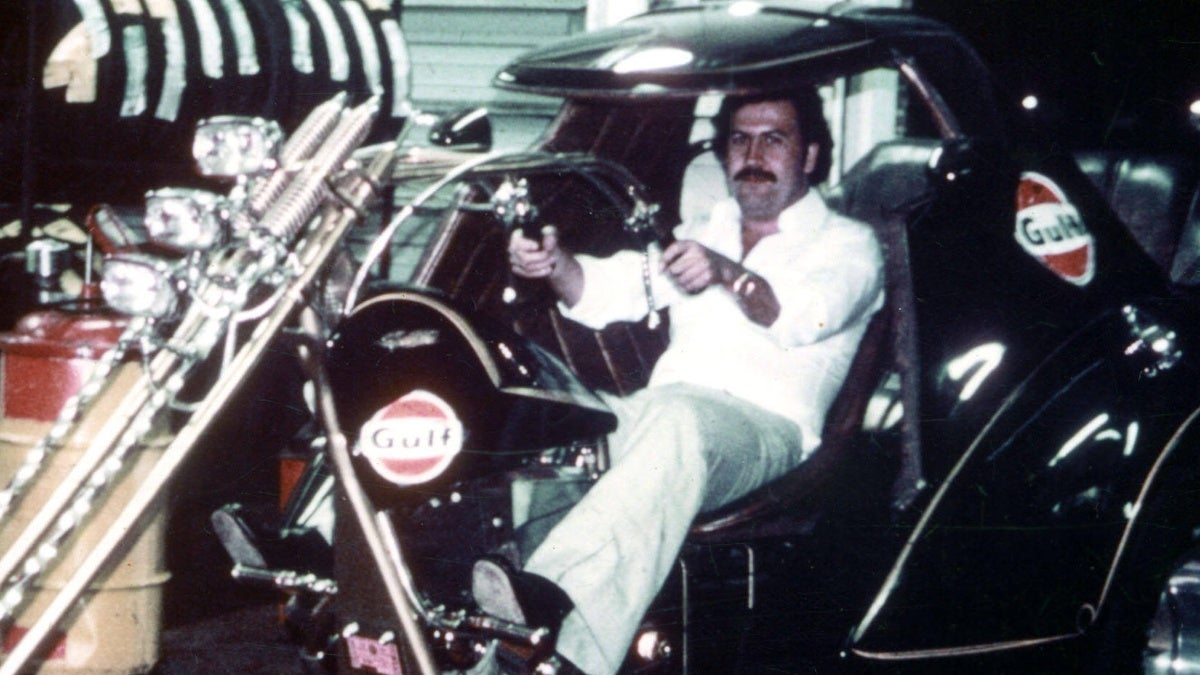
As a result, coca cultivation in Colombia has exploded in the last five years.
This trend may seem counterintuitive, after the expectations generated by the Peace Agreement signed on November 24, 2016 between the Colombian government and the Revolutionary Armed Forces of Colombia (Fuerzas Armadas Revolucionarias de Colombia, FARC) – the very terrorist group that managed, protected, and was financed by the cocaine trade.
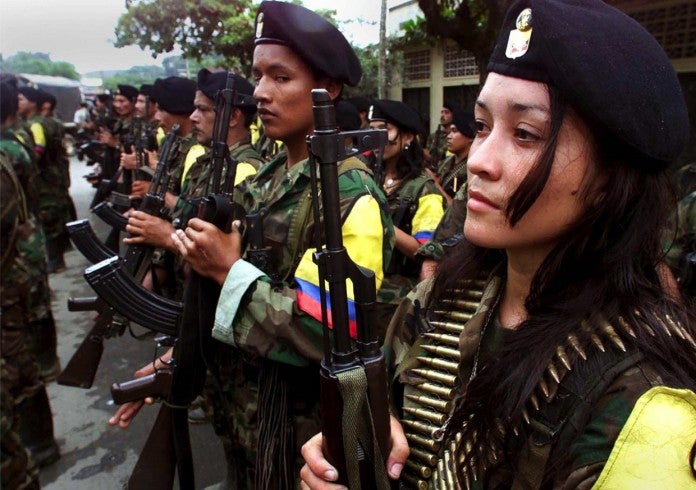
To combat drug trafficking, the US Congress approved Plan Colombia in July 2000, which was a cooperation agreement signed between the US and Colombian governments.
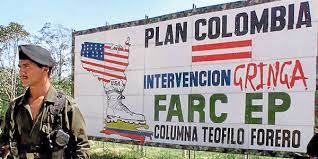
The importance given to Plan Colombia by the US government is evidenced by the fact that it has been allocated more than US$8 billion in funding since its inception, an amount that exceeds any other US foreign policy project after the end of the Cold War, except for those related to the Middle East, Afghanistan and Iraq.
However, drug trafficking is still widespread and evolving.
Nowadays, there are national and international reasons for this new expansion of criminal networks linked to the production and trafficking of cocaine in Colombia and beyond.
First and foremost is “the complementarity between the business models of cocaine production and illicit gold mining, as the latter has become a major catalyst for the former“.
Gold has become a de facto hard standard currency for drug traffickers, and the two business models – illicit gold mining and drug trafficking – are complementary, as they share suppliers and their respective value chains are closely linked and correlated.
Additionally, the announcement of the 2016 Peace Agreement in Colombia sowed uncertainty among criminal groups due to the potential change in the operating environment of their business models.
It is worth noting that, although it may seem contradictory, “the [peace] agreement created the expectation of new revenue streams for cartel organisations and local farm owners based on the rational incentive created by the promises – manipulated and inflated by the FARC itself – of future state aid for the introduction of replacement crops among coca farmers“.
Those promises ultimately led to the accelerated growth of coca cultivation, with farmers expecting to benefit at a later stage from these expected subsidies.
In addition, “the suspension of aerial spraying in 2015 – which risked destroying up to one-third of coca plantations – led to less eradication of cultivated areas at a time when prices in traditional consumer markets for cocaine were rising and [are] still rising today“.
It also needs to be emphasised that new generations of drug traffickers are emerging who tend to operate in a more fragmented way.
Indeed, “it is now more difficult to pinpoint the number of individuals mobilised by organised crime and associated with drug trafficking, because criminal groups are more atomised“.
Moreover, these new organisations behave differently from their predecessors in that they do not commit irrational and indiscriminate criminal acts.
In fact, as these new groups move into the areas traditionally occupied by the FARC, murder rates are decreasing.
“These new criminal organisations act as rational actors and tend to maintain peace in geographic areas which they bring under their control because of their interest in protecting their business models“.
Removing the top leadership of these organisations would not necessarily guarantee their dismemberment, as used to be the case with traditional drug cartels in the past.
Secondly, in recent years, “there has been a growing interest on the part of the security services in Latin America and also in Europe in the renewed association of the drug cartels – in their various denominations and from their numerous bases of operation throughout the [Latin] American continent – with politics“.
This is especially true of authoritarian regimes such as those in Venezuela or Nicaragua, and of some past or present governments in Bolivia, Ecuador, Argentina or Mexico, or even of political parties and movements with populist, left-wing, and communist leanings in Latin America and southern Europe.
However, the great challenge in the fight against the spread of organised criminal networks in Colombia around the cultivation, production, distribution, and sale of cocaine lies in the fact that their business models cannot be understood without Europe as one of their top markets and therefore without their connections to Europe.
And within this framework, Spain is now a crucial link for the Colombian, Venezuelan, Peruvian, and Bolivian drug traffickers.
Hence, the strategic interest of Narco-States and governments dependent on drug trafficking in Latin American to infiltrate, penetrate, and capture the Spanish political system to advance their criminal agenda, which is heir to the combined legacy of Fidel Castro and Pablo Escobar Gaviria.

Europe is an attractive and developing market for drug traffickers for two reasons:
Firstly, the price paid per kilo of cocaine in European markets is US$20,000, compared to US$7,000 in the US.
Of course, these prices are not comparable to the US$80,000 per kilo paid in Russia or the US$100,000 per kilo paid in China.
These two markets are indeed the most profitable for drug cartels, although they are both more difficult for them to access.
These price differentials reflect the costs associated with the more complex supply chains and distribution channels that result from the physical distance between production centres and points of sale.
Secondly, Europe is more attractive as a market for Colombian drug traffickers than the US, because the North America route from Latin America inevitably forces them to face tough competitors, currently represented by the Mexican Clan (or cartel) de Sinaloa, unless costly arrangements are made between the former with the latter.
It is also worth noting that the Colombian cartels are also facing increasing market competition from leading Mexican cartels that are rapidly vertically integrating their business models through the direct purchase of coca cultivation lands in Colombia.
Thirdly, the consequence of this growing competition, albeit sometimes accompanied by new cooperation, is that “the logistical routes used by Colombian drug traffickers to reach European markets essentially cross through Venezuela, Peru, Brazil, Argentina, some countries in the Caribbean and Africa“, resulting in cooperation with international terrorism.
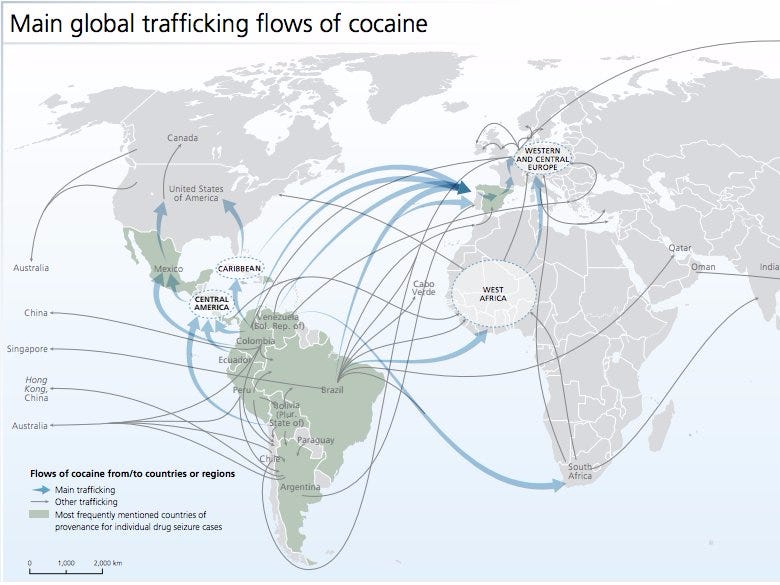
The risks associated with the current political situation in Venezuela and the growing role played by the so-called Clan de los Soles – which is allegedly controlled by the Venezuelan government – and the convergence between crime and politics in drug trafficking across the Americas and Europe are forcing more traditional criminal groups to reconsider the routes they use to bring their supplies to Europe.
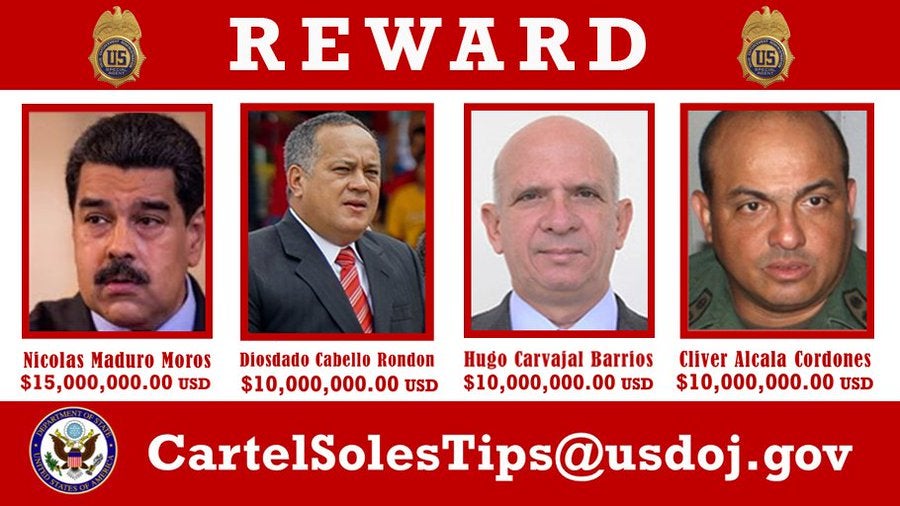
Peru and Brazil (which are often described by the Colombian government as the world’s largest cocaine exporters) as well as Argentina and some nations in the Caribbean have become the region’s main export hubs to the rest of the world, and as a result their domestic markets have been growing dramatically for years.
For its part, the Colombian government seizes six times more cocaine than the rest of the Latin American countries combined.
As a symptom of the routes that criminal groups use to transport cocaine within the region before exporting it to Europe, the main seizures carried out by the Colombian government occur largely at sea, but very rarely on river routes and not at all on land.
“Africa – more specifically Mauritania, although not exclusively, and the Sahel – has become in recent years an intermediate logistical base from which cocaine traffickers head for the European market, [in the belief] that this change in routines and routes will make it easier to evade surveillance by customs authorities and European security forces“.
The geographical Sahel (the word means “border“) is an area 500 km wide and 5,400 km long that separates Arab and Berber northern Africa from the southern parts of the continent occupied largely by black people.
The Sahel is the main route of road transport between the north and south or east and west of Africa.
The two main challenges for countries bordering the southern boundary of the Sahara Desert – i.e. the Sahel – are security and economic development.
In fact, the two are directly linked, and the link between the two is trade.
For international and regional organisations, as well as national governments in the region, “the most troubling trade deals taking place in the Sahel are those involving the so-called ‘three deals’ – drugs, people and weapons. And they all have the same destination: Europe“.
And for these purposes, “Latin American cartels and jihadists are the perfect partners in crime – the former delivering the goods to the latter, who are charged with the responsibility of protecting the cargoes and transporting them to Europe“.
Indeed, the Sahel lives under strained economic and social conditions – a high level of poverty among the populations of countries in the region, low levels of human development, and a high fertility rate (which, for example, averages 7.1 births per woman in the case of Niger).
“In countries like Mauritania, formal roads are considered safe zones“, and experts in the field usually refer to the fact that the country’s security forces are instructed to consider any vehicle moving outside these roads “as an enemy worthy of immediate engagement“.
The criminality associated with the drugs business model has changed the behaviour of the leading drug traffickers compared to those of the past.
In Colombia, Escobar died impoverished after attempting to challenge the state, while the Cali cartel ceded approximately two thousand businesses to the state when it submitted itself to justice.
Today, although criminal groups can be overly aggressive in defending their markets and business models against those of their competitors, they prefer to avoid violence, because they believe it can be detrimental to an increasingly diversified business model with interests in other types of criminal revenue streams, such as the illegal migration of people or prostitution: “It is easier and more advantageous for organised crime groups to corrupt the police, the judicial and prison systems, and the political establishment – as drug traffickers have successfully done in Mexico by penetrating society and institutions – than to fight them“.
Given this huge build-up of Colombian drug supply chains on both sides of the Atlantic, “European governments, in cooperation with the Colombian authorities, have a crucial role to play in combating this [phenomenon]“.
For example, the United Kingdom is the Colombian government’s greatest ally in providing advanced intelligence on the transportation, access, wholesale, retail, and profit laundering of the drug business in the European continent.
Good practices such as these show that there is room for the further development of this collaboration and the institutional strengthening of cooperation with other European countries.
In essence, “key intelligence needs to be shared and eventually formalised in new internal processes and procedures, both within justice systems and within security force operations, so that it goes beyond the good personal relationships that have been built here and there“.
_____________________________________________________________________________________
NB 1 – Quotes in italics and bold are attributable to senior officials from national governments and regional and international organisations whom the author had the privilege to meet with. Their names and affiliations cannot be shared. This blog represents the author’s views only.
NB 2 – A similar version of this blog was previously published by the Geneva Centre for Security Policy (GCSP) on October 12th, 2021: https://www.gcsp.ch/global-insights/bad-actors-i-narcos
EconomíaEspañaMundoOtros temasUnión EuropeaYihadismo
Tags
- 'Three deals'
- 2000
- 2015
- 2016
- Actors
- Advanced intelligence
- Aerial spraying
- Afghanistan
- África
- Agenda
- Agreement
- Aid
- Ally
- Arab
- Areas
- Argentina
- Association
- Attractive market
- Authoritarian regimes
- Bad Actors
- Bases
- Bases of operations
- Berber
- Births
- Black people
- Bolivia
- Bolivian drug traffickers
- Border
- Brazil
- Business models
- Businesses
- Cali
- Cali cartel
- Capture
- Cargoes
- Caribbean
- Cartel of Sinaloa
- Cartel organisations
- Challenges
- China
- Clan de los Soles
- Clan de Sinaloa
- Coca
- Coca cultivation lands
- Coca farmers
- Coca plantations
- Cocaine
- Cocaine exporters
- Cocaine trade
- Cold War
- Collaboration
- Colombia's domestic politics
- Colombian authorities
- Colombian drug cartels
- Colombian drug traffickers
- Colombian government
- Combat
- Combined legacy of Fidel Castro nd Pablo Escobar Gaviria
- Commercialisation of cocaine
- Commercislisation
- Communist
- Competition
- Competitors
- Complex distribution channels
- Complex supply chains
- Congress
- Connections
- Consumer
- Consumer markets
- Continent
- Control
- Convergence
- Convergence between crime and politics
- Cooperation
- Cooperation agreement
- Costs
- Crime
- Criminal acts
- Criminal agenda
- Criminal groups
- Criminal networks
- Criminal revenue streams
- Criminality
- Crops
- Cultivated areas
- Cultivation
- Cultivation of cocaine
- Currency
- Custom
- Custom authorities
- Deals
- Destination
- Developing market
- Development
- Direct purchase of coca cultivation lands
- Distribution channels
- Diversified business model
- Domestic markets
- Domestic politics
- Drug
- Drug cartels
- Drug traffickers
- Drug trafficking
- East
- East of Africa
- Economic conditions
- Ecuador
- Enemy
- Engagement
- Environment
- Eradication
- Escobar
- Establishment
- Europe
- European governments
- European markets
- European security forces
- Expansion of criminal networks
- Experts
- Export hubs
- Exporters
- FARC
- Farm
- Farm owners
- Farmers
- Fertility
- Fertility rate
- Fidel
- Fidel Castro
- Fight
- Formal roads
- Fuerzas Armadas Revolucionarias de Colombia
- Fuerzas Armadas Revolucionarias de Colombia (FARC)
- Funding
- Future state aid
- Geographic areas
- Geostrategic rivalry
- Gold
- Gold mining
- Good practices
- Goods
- Government
- Government dependent on drug trafficking
- Groups
- Hard standard currency
- Human development
- Illicit gold mining
- Illigal migration of people
- Incentive
- Indiscriminate criminal acts
- Individuals
- Individuals mobilised by organised crime
- Infiltrate
- Institutions
- Intelligence
- Intermediate logistical base
- International groups
- International non-state groups
- International organisations
- International terrorism
- Iraq
- Irrational and indiscriminate criminal acts
- Irrational criminal acts
- Jihadists
- Judicial and prison systems
- Judicial system
- Justice
- Key intelligence
- Kilo of cocaine
- Land
- Latin America
- Latin American continent
- Leader
- Leadership
- Leading Mexican cartels
- Left-wing
- Link
- Local farm owners
- Logistical base
- Logistical routes
- Market competition
- Markets
- Mauritania
- México
- Middle East
- Migration
- Migration of people
- Mining
- Movements
- Murder
- Murder rates
- Narco-States
- Narcos
- National governments
- Networks
- New generation of drug traffickers
- New organisations
- New revenue streams
- Nicaragua
- Níger
- Non-state groups
- North
- North America
- North America route
- North of Africa
- Northern Africa
- Operating environment
- Organisations
- Organised crime
- Pablo Escobar
- Partners in crime
- Peace Agreement
- Penetrate
- People
- Peruvian drig traffickers
- Physical distance
- Plan Colombia
- Plantations
- Points of sale
- Police
- Political actors
- Political establishment
- Political institutions
- Political parties
- Political system
- Politics
- Populations
- Populist
- Poverty
- Price differentials
- Prices
- Prison system
- Processing
- Processing of cocaine
- Production
- Production centres
- Profit laundering
- Profitable
- Promises
- Prostitution
- Purchase
- Rational actors
- Rational incentive
- Regimes
- Región
- Regional organisations
- Replacement crops
- Revenue
- Revenue streams
- Revolutionary Armed Forces of Colombia (FARC)
- Rivalry
- River
- River routes
- Road transport
- Roads
- Routes
- Routines
- Russia
- Safe zones
- Sahara Desert
- Sahel
- Sale
- Sale of cocaine
- Sea
- Security
- Security force operations
- Security forces
- Security services
- Security services in Latin America
- Seizures
- Sinaloa
- Social conditions
- Society
- South
- South of Africa
- Southern boundary
- Southern boundary of the Sahara desert
- Southern Europe
- Soviet Union
- Spain
- Spanish political system
- Standard currency
- State
- State aid
- Strained economic and social conditions
- Strategic interest
- Subsidies
- Suppliers
- Supplies
- Supply chains
- Surveillance
- Terrorism
- Terrorist group
- The Sahel
- Top leadership
- Top markets
- Tough competitors
- trade
- Trade deals
- Traditional consumer markets
- Traditional consumer markets for cocaine
- Transnational Organised Crime
- Trend
- Uncertainty
- United Kingdom
- United States (US)
- Unites States
- US
- US Congress
- US foreign policy
- US foreign policy project
- US government
- Value
- Value chains
- Vehicle
- Venezuela
- Venezuelan drug traffickers
- Venezuelan government
- Violence
- War
- Weapons
- West of Africa
- Wholesale
- Wholesale of cocaine
- Woman
- World
- Zones

